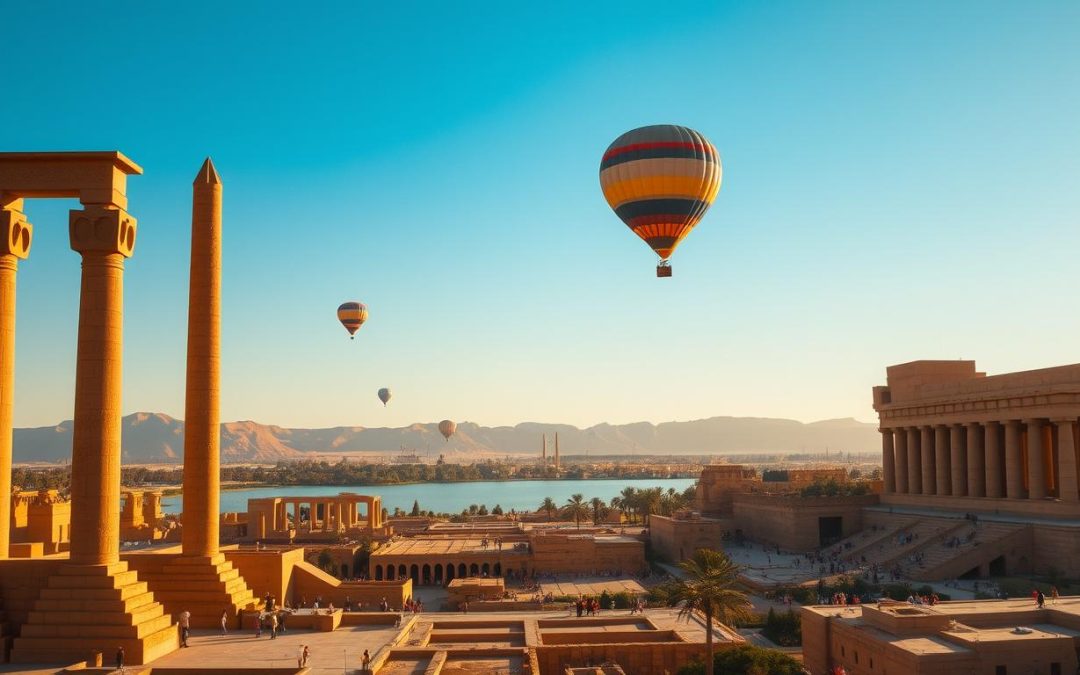Have you ever wondered what it’s like to step back in time and walk among the remnants of an ancient civilization? This city, often referred to as the world’s greatest open-air museum, offers a unique blend of history, culture, and modern travel experiences. From towering temples to royal tombs, every corner tells a story of a bygone era.
Whether you’re a history enthusiast or simply looking for an unforgettable adventure, this destination has something for everyone. Its rich heritage and stunning landmarks make it a highlight of any trip to the region. Let’s dive into what makes this place so special and explore the top attractions that await you.
Key Takeaways
- Discover the city’s ancient temples and royal tombs.
- Experience a mix of history and modern travel conveniences.
- Learn why this destination is a must-visit in the region.
- Get insider tips from travel experts for a seamless visit.
- Explore unique local experiences beyond the famous landmarks.
Explore Luxor’s Timeless Heritage
Step into a world where ancient stories come alive through towering monuments and sacred ruins. This city is a treasure trove of history, offering a glimpse into a civilization that thrived thousands of years ago. From grand temples to intricate carvings, every corner tells a story of power, faith, and innovation.
Dive into Ancient History
The heritage of this city spans millennia, with ruins and preserved monuments that showcase the brilliance of ancient architects. The Karnak Temple Complex, for example, took over 2,000 years to build, reflecting the dedication and skill of its creators. These structures were not just places of worship but also symbols of the pharaohs’ divine authority.
Walking through these sites, you’ll feel the weight of history. The towering columns of the Hypostyle Hall and the intricate carvings on temple walls are testaments to a civilization that valued art, science, and spirituality. Each stone tells a story, from the rise of powerful rulers to the daily lives of ordinary people.
Discover Cultural Influences
Ancient influences are visible in every corner of the city. The Avenue of Sphinxes, stretching 2.7 km, connects two major temples, showcasing the grandeur of ceremonial paths. The Valley of the Kings, with over 60 tombs, reveals the burial practices and beliefs of the time. These sites are not just relics of the past but windows into a culture that shaped the world.
Exploring these landmarks enriches your travel experience. You’ll gain a deeper understanding of how the pharaohs ruled, how their beliefs influenced architecture, and how their legacy continues to inspire. It’s a journey that connects you to the roots of human civilization.
- Ruins and Monuments: Discover sites that have stood the test of time.
- Cultural Insights: Learn how ancient beliefs shaped art and architecture.
- Pharaohs’ Legacy: Explore the stories of rulers who left their mark on history.
Uncover the Wonders of Luxor Temple
Immerse yourself in the grandeur of one of the most iconic temples in the world. This ancient site, dating back to 1400 BCE, has witnessed centuries of history and remains a testament to the brilliance of its creators. Known as a coronation site for kings, the temple holds a special place in the annals of time.
History Behind the Ruins
The Luxor Temple was constructed during the reign of Amenhotep III and later expanded by Ramses II. Its evolution over the years reflects the changing dynasties and their architectural innovations. The temple was not just a place of worship but also a symbol of divine authority.
Walking through its halls, you’ll see towering columns, intricate carvings, and statues that tell stories of power and faith. Each stone is a piece of history, offering a glimpse into the lives of those who built and used this sacred space.
Best Times for a Visit
To fully appreciate the temple’s beauty, timing is key. Early mornings are ideal for avoiding crowds and capturing stunning photos. The soft light enhances the details of the carvings and statues. Evenings, however, offer a magical experience as the temple is illuminated, casting a golden glow over the ancient stones.
Here’s a quick guide to help you plan your visit:
| Time of Day | Experience |
|---|---|
| Morning | Quiet, perfect for photography |
| Afternoon | Warmer, fewer visitors |
| Evening | Illuminated, magical ambiance |
The temple’s cultural significance goes beyond its architecture. It was a place where rituals and ceremonies took place, connecting the people to their gods and rulers. Visiting this site is not just a journey through history but also an opportunity to understand the beliefs and practices of an ancient civilization.
Marvel at the Pillars of Karnak Temple
Step into a world where colossal columns and towering obelisks tell tales of ancient grandeur. The Karnak Temple complex is a masterpiece of architecture, showcasing the brilliance of its creators. Every corner of this site reflects the dedication and skill of those who built it over centuries.
The Great Hypostyle Hall
The Great Hypostyle Hall is the heart of Karnak Temple. With 134 massive columns, it’s a sight that leaves visitors in awe. Each column stands tall, adorned with intricate carvings that depict stories of gods and pharaohs. Walking through this hall, you’ll feel the weight of history surrounding you.
These columns were designed to support the temple’s roof, creating a space that felt both grand and sacred. The sheer scale of the hall is a testament to the ingenuity of ancient architects. It’s a must-see for anyone visiting the temple complex.
Obelisks and Monumental Statues
Scattered throughout the temple are towering obelisks and statues that add to its grandeur. These structures were often built under the direction of pharaohs like Ramses II. Each obelisk is a marvel of engineering, carved from a single piece of stone and covered in hieroglyphs.
The statues, too, are impressive. They depict gods, pharaohs, and mythical creatures, each with intricate details. These monuments were not just decorative but also served as symbols of power and devotion.
Here’s a quick guide to help you make the most of your visit:
| Time of Day | Experience |
|---|---|
| Morning | Best for photography and fewer crowds |
| Afternoon | Warmer, but quieter |
| Evening | Illuminated for a magical ambiance |
The temple’s construction spanned centuries, with contributions from pharaohs like Amenhotep III. Their vision and dedication shaped this iconic site. Visiting Karnak Temple is not just a journey through history but also a chance to witness the genius of an ancient civilization.
Discover Luxor Museum & Mummification Museum
Dive into the heart of ancient Thebes and uncover the secrets of its past through two fascinating museums. These sites offer a unique blend of education and awe, making them must-visit attractions for history enthusiasts.
Highlights of the Luxor Museum
The Luxor Museum is a treasure trove of artifacts that reveal daily life and religious practices in ancient Thebes. Its well-curated exhibits include statues, pottery, and tools that tell the story of a civilization that thrived thousands of years ago.
One standout piece is the statue of Amenhotep III, which showcases the artistry of the time. The museum’s layout is easy to navigate, ensuring a seamless experience for visitors. It’s a journey through time that connects you to the roots of human civilization.
Understanding Ancient Mummification
The Mummification Museum offers a deep dive into the ancient practice of preserving the dead. Here, you’ll learn about the intricate process and its cultural significance. Exhibits include mummified animals, tools used in the process, and detailed explanations of the rituals involved.
One of the most fascinating displays is the mummy of a high-ranking priest, complete with the amulets and wrappings used in the process.
“Mummification was not just about preserving the body; it was a sacred act that ensured the soul’s journey to the afterlife.”
- Key Exhibits: Discover artifacts that reveal daily life and religious practices.
- Mummification Process: Learn about the cultural importance of this ancient practice.
- Standout Artifacts: See statues and mummies that attract history enthusiasts.
- Layout and Accessibility: Both museums are easy to navigate, ensuring a pleasant visit.
- Travel Itinerary: Include these museums in your plans for a comprehensive historical experience.
Luxor, Egypt: Best Things to Do – Top Picks
This destination is a treasure trove of ancient wonders, blending history, culture, and modern travel seamlessly. From towering temples to royal tombs, every site tells a story of a civilization that shaped the world we know today. Whether you’re a history buff or a curious traveler, there’s something here for everyone.
- Luxor Temple: A coronation site for kings, this temple is a masterpiece of ancient architecture.
- Karnak Temple: Marvel at the Great Hypostyle Hall and towering obelisks.
- Luxor Museum: Dive into the daily life and religious practices of ancient Thebes.
- Mummification Museum: Learn about the sacred art of preserving the dead.
Each of these landmarks offers a unique glimpse into the past, making your visit unforgettable. To help you plan, here’s a quick guide to the best times to explore:
| Time of Day | Experience |
|---|---|
| Morning | Quiet, perfect for photography |
| Afternoon | Warmer, fewer visitors |
| Evening | Illuminated, magical ambiance |
Ready to dive deeper? Keep reading for detailed guides on each of these iconic locations. Your adventure in this historic city is just beginning!
Journey Through the West Bank: Valley of the Kings
Walk through a valley that holds the eternal resting places of Egypt’s greatest rulers. This ancient burial site, nestled on the west bank of the Nile, is a testament to the grandeur and mystery of a bygone era. With over 60 tombs discovered so far, the Valley of the Kings continues to captivate archaeologists and travelers alike.
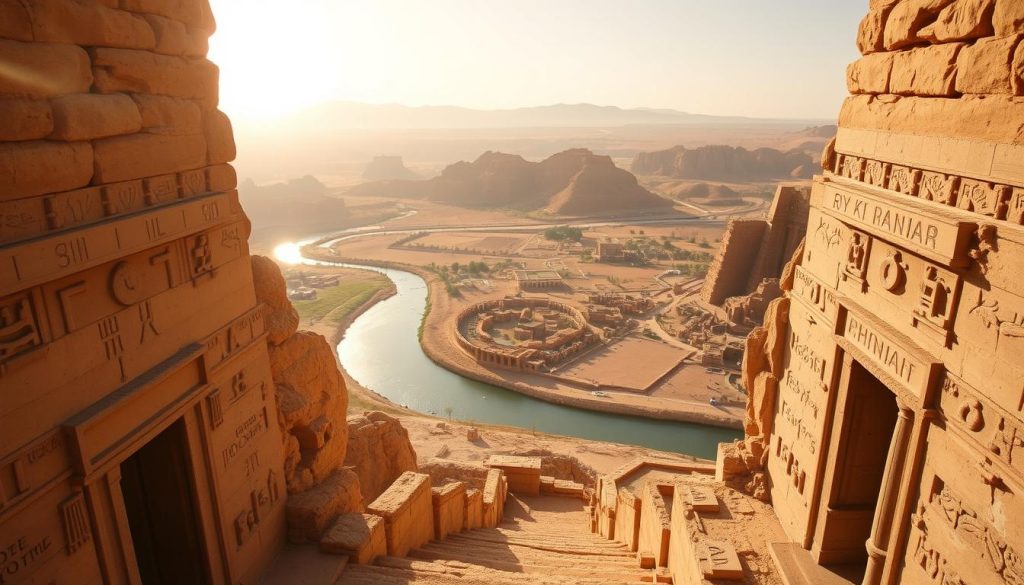
Royal Tombs and Their Stories
Each tomb in the valley tells a unique story of power, faith, and legacy. The most famous is the tomb of Tutankhamun, discovered in 1922. Its treasures offer a glimpse into the life and death of the young pharaoh. Other notable tombs include those of Ramses VI and Seti I, known for their intricate carvings and vibrant wall paintings.
These tombs were not just burial sites but also elaborate passageways to the afterlife. The decorations and artifacts found within reflect the beliefs and rituals of ancient Egyptians. Exploring them is like stepping into a time capsule of history.
Tips for Exploring the Valley
To make the most of your visit, plan ahead. The valley operates from 6 am to 4 pm in winter and 6 am to 5 pm in summer. Early mornings or late afternoons are ideal for avoiding crowds and enjoying cooler temperatures. A typical visit lasts 1-3 hours, depending on how many tombs you explore.
Here’s a quick guide to help you navigate:
| Item | Cost (EGP) |
|---|---|
| General Admission (3 tombs) | 750 |
| Tutankhamun’s Tomb (KV62) | 700 |
| Ramses V & VI (KV9) | 220 |
| Tram Ticket (round trip) | 20 |
For a more comprehensive experience, consider the Luxor Pass, which grants access to multiple sites. Remember to wear comfortable shoes and bring water, as the desert heat can be intense.
The Valley of the Kings is more than just a tourist destination; it’s a journey into the heart of ancient Egypt. Whether you’re drawn by history, archaeology, or sheer curiosity, this site promises an unforgettable adventure.
Stroll Around the Temple of Hatshepsut
Discover a temple that stands as a testament to one of history’s most powerful female rulers. This architectural marvel, built in the 15th century BC, is a must-see for anyone fascinated by ancient history. Its terraced design and stunning location make it a highlight of any visit.
Architectural Marvels
The temple’s multi-tiered design is unlike anything else from its time. Built into a cliff face, it features three levels connected by ramps. Each level is adorned with columns, statues, and intricate carvings that tell stories of the past. The symmetry and grandeur of the structure reflect the ambition of its creator, Queen Hatshepsut.
As you explore, you’ll also find murals depicting trade expeditions and religious rituals. These artworks provide a glimpse into the life and achievements of one of the few female pharaohs in history. The temple’s design and decorations are a testament to her legacy.
A Unique Experience for History Buffs
For history enthusiasts, this temple offers a deep dive into the 15th century BC. The carvings and inscriptions reveal details about Hatshepsut’s reign and her efforts to legitimize her rule. You’ll also find quieter sections away from the main crowds, perfect for reflection and photography.
Here are some tips to enhance your visit:
- Photography Spots: The upper terraces offer panoramic views of the surrounding landscape.
- Quiet Moments: Explore the less crowded areas for a more intimate experience.
- Historical Insights: Take time to study the murals and carvings that tell stories of the past.
This temple is more than just a historical site; it’s a journey into the life and legacy of a remarkable ruler. Whether you’re a history buff or simply curious, it’s an experience you won’t forget.
Experience the Colossi of Memnon
Stand before the towering Colossi of Memnon and feel the weight of history. These massive statues, standing at 60 feet tall, have watched over the land for over 3,000 years. They were built to guard the mortuary temple of Pharaoh Amenhotep III, a testament to the grandeur of ancient craftsmanship.
The colossi are more than just statues; they are symbols of an era long past. Carved from single blocks of quartzite sandstone, they showcase the incredible skill of ancient engineers. Despite the temple’s ruins, the Colossi of Memnon remain intact, offering a glimpse into the power and ambition of their creator.
Visiting these statues is a serene experience. The open landscape around them adds to their mystique, creating a peaceful ambiance. It’s a quick stop on your journey, but one that leaves a lasting impression. Don’t forget to capture the moment with a photo—these colossi make for an amazing backdrop.
- Historical Significance: Learn about their role in guarding a pharaoh’s temple.
- Impressive Scale: Marvel at their 60-foot height and intricate details.
- Serene Ambiance: Enjoy the peaceful surroundings that enhance their mystique.
- Photo Opportunity: Capture the grandeur of these ancient statues.
- Reflection: Pause and consider the passage of time they represent.
These statues are more than just relics; they are a connection to a world that shaped history. Whether you’re a history enthusiast or a casual traveler, the Colossi of Memnon offer a moment to reflect on the enduring legacy of ancient civilizations.
Step Back in Time at Medinet Habu
Journey to a place where history is etched into every stone. Medinet Habu, a temple complex on the west bank of the Nile, is a masterpiece of ancient architecture. Built during the reign of Ramesses III, it stands as a testament to his victories and the grandeur of his era.
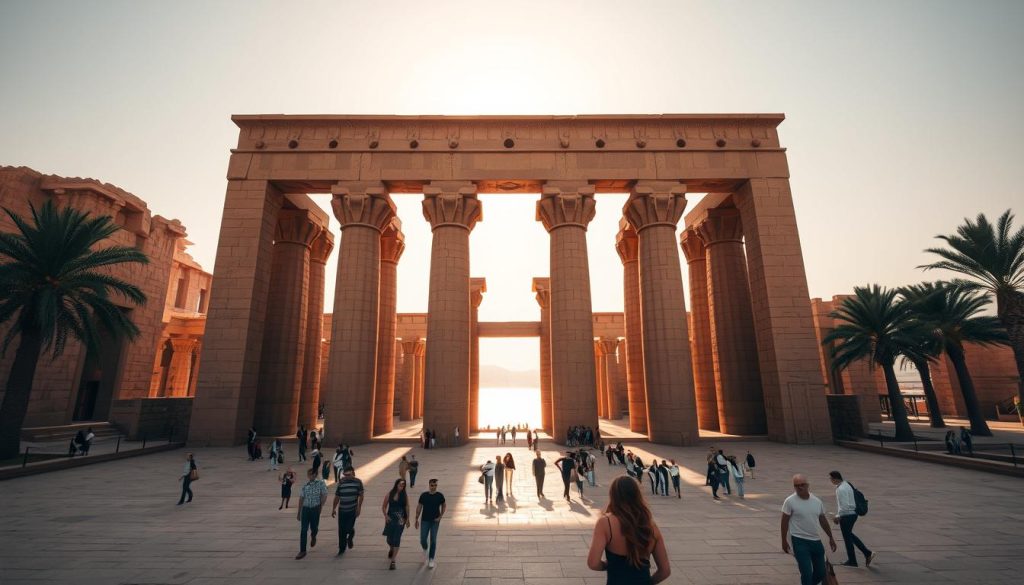
Exploring the Reliefs and Inscriptions
The walls of Medinet Habu are adorned with dramatic reliefs and intricate carvings. These depict the pharaoh’s triumphs over the “sea-people” and his control over regions like Syria and Nubia. Each wall tells a story, offering a glimpse into the military and cultural achievements of the time.
One of the most striking features is the detailed hieroglyphics. They not only showcase artistic skill but also serve as historical records. The temple’s inscriptions are remarkably well-preserved, making it a treasure trove for historians and visitors alike.
Tips for Visiting Medinet Habu
To fully appreciate the site, plan your visit during the early morning or late afternoon. The soft light enhances the details of the carvings, and the cooler temperatures make exploration more comfortable. Here are some tips to make the most of your visit:
- Best Viewing Spots: Focus on the outer walls and the inner courtyards for the most detailed reliefs.
- Artistic Value: Take time to study the hieroglyphics and carvings—they reveal the cultural and historical significance of the site.
- Timing: Arrive early to avoid crowds and enjoy the serene ambiance.
Medinet Habu is more than just a temple; it’s a journey into the past. Whether you’re a history enthusiast or a curious traveler, this site offers a unique opportunity to connect with ancient Egypt’s legacy.
Visit Howard Carter House to Relive the Past
Step into the home of the man who uncovered one of history’s greatest treasures. The Howard Carter House offers a unique tour into the life and work of the archaeologist who discovered Tutankhamun’s tomb. This historic site is a window into early 20th-century archaeology and the dedication behind one of the most significant finds in history.
The house has been meticulously preserved, showcasing vintage interiors and period furnishings. As you walk through the rooms, you’ll see where Carter planned his excavations and analyzed artifacts. The atmosphere feels frozen in time, offering a nostalgic glimpse into the past.
This tour is not just about the house; it’s about the story behind the discovery. You’ll learn about Carter’s perseverance, the challenges he faced, and the excitement of unearthing Tutankhamun’s tomb. It’s an educational experience that brings history to life.
Here are some tips to make the most of your visit:
- Timing: Arrive early to avoid crowds and enjoy a more intimate experience.
- Guided Tours: Consider a guided tour for deeper insights into Carter’s life and work.
- Photography: Capture the preserved interiors and the tools Carter used during his excavations.
The Howard Carter House is more than a historical site; it’s a journey into the heart of archaeology. Whether you’re a history enthusiast or simply curious, this tour offers a unique opportunity to connect with the past.
Soar Above Luxor: Hot Air Balloon Rides
Imagine floating above the earth, watching the world wake up beneath you. A hot air balloon ride over this historic city offers a perspective like no other. As you gently rise into the sky, the first light of dawn bathes the landscape in soft hues, creating a magical experience.
From the balloon, you’ll see the winding Nile, ancient temples, and the vast desert stretching into the horizon. The aerial view allows you to appreciate the scale and grandeur of landmarks like the Valley of the Kings and the Temple of Hatshepsut. It’s a breathtaking way to connect with history.
Enjoying Sunrise from the Sky
Early mornings are the best time for a balloon ride. The cool air and soft light enhance the beauty of the landscape. Most flights take off between 4:30 AM and 5:30 AM, ensuring you catch the sunrise. The ride typically lasts 45 minutes to an hour, giving you plenty of time to soak in the views.
Here’s what to expect during your hot air balloon adventure:
- Preparation: Arrive early for a safety briefing and to watch the balloon inflation process.
- Takeoff: Feel the excitement as the balloon lifts off, offering a smooth ascent.
- Flight: Enjoy panoramic views of the Nile, temples, and desert.
- Landing: Most landings are soft, though some may be bumpier depending on conditions.
Booking a balloon ride is straightforward. Many companies operate in the area, and prices range from $80 to $150 per person. For a more exclusive experience, some operators offer private flights. Always check safety records and reviews before booking.
This adventure is perfect for those seeking a unique and memorable experience. Whether you’re a history enthusiast or simply love breathtaking views, a hot air balloon ride over this historic city is an unforgettable addition to your itinerary.
Essential Travel Tips for Your Luxor Adventure
Planning your trip to this historic city requires careful consideration of timing, budget, and essentials. Whether you’re a first-time visitor or a seasoned traveler, these tips will help you make the most of your journey.
When to Visit and What to Expect
The best time to explore this destination is from October to April. During these months, the weather is mild, making it ideal for outdoor activities. December and January are peak tourist seasons, so expect larger crowds and higher prices.
If you prefer a quieter experience, consider visiting in late October or early March. The temperatures are still pleasant, and you’ll have more space to enjoy the landmarks. Early mornings are perfect for visiting popular sites like the temples and tombs, as they are less crowded.
Packing and Budgeting Advice
Packing smart is key to a comfortable trip. Bring lightweight, breathable clothing for the day and a light jacket for cooler evenings. Don’t forget sunscreen, a hat, and comfortable walking shoes. A reusable water bottle is also essential to stay hydrated.
Here’s a breakdown of typical daily expenses:
- Accommodation: Budget options start at $20 per night, while mid-range hotels cost around $50-$80.
- Food: Local meals cost $5-$10, while dining at upscale restaurants can range from $20-$40.
- Transport: Taxis and rideshares are affordable, with short trips costing $2-$5. Consider renting a bike for a more immersive experience.
- Admission Fees: Entry to major sites ranges from $10-$20 per person.
To save money, book accommodations and tours in advance. Bargaining is common in local markets, so don’t hesitate to negotiate prices.
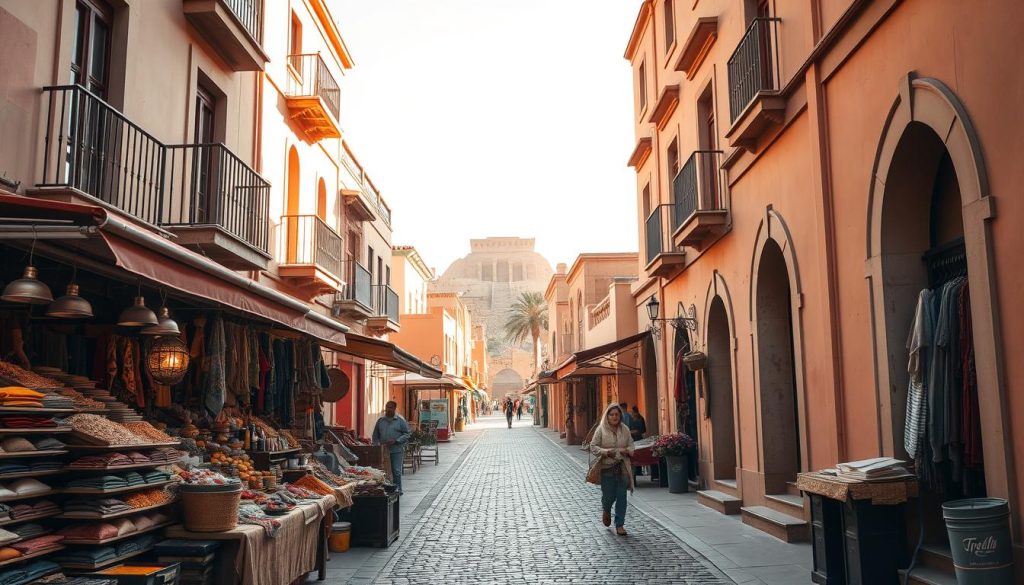
With these tips, you’re ready to embark on an unforgettable adventure. Plan ahead, pack wisely, and enjoy every moment of your journey through this historic city.
Navigating From Cairo to Luxor
Traveling from Cairo to Luxor offers a variety of transportation options, each with its own unique advantages. Whether you prefer speed, comfort, or affordability, there’s a way to suit your needs. Let’s explore the pros and cons of trains, buses, and flights to help you decide the best way to make the journey.
Train, Bus, and Flight Options
The sleeper train is a popular choice for travelers seeking a comfortable and scenic ning experience. Operated by Watania, the train takes approximately 10.5 hours and offers cabins with beds and shared toilets. Prices range from $120 for a single cabin to $160 for a double. Early morning views of the sunrise over rural landscapes make this option memorable.
Buses are a budget-friendly alternative, with several companies offering routes from Cairo to Luxor. The journey takes around 10-12 hours, depending on traffic and stops. Tickets are affordable, but comfort levels vary. Be prepared for a noisier and bumpier ride compared to the train.
For those short on time, flights are the fastest option. A one-hour flight can cost as little as $35 if booked in advance. Airlines like EgyptAir operate daily flights, making it a convenient choice. However, keep in mind additional costs for luggage and transfers to and from airports.
| Option | Duration | Cost | Comfort |
|---|---|---|---|
| Sleeper Train | 10.5 hours | $120-$160 | High |
| Bus | 10-12 hours | $10-$20 | Moderate |
| Flight | 1 hour | $35+ | High |
When planning your trip, consider your budget and comfort preferences. If you’re traveling onward to aswan, the train or bus might be more convenient. For a quick and hassle-free journey, a flight is your best bet. No matter which option you choose, you’re in for an unforgettable adventure.
Where to Stay and Dine in Luxor
Finding the perfect place to stay and dine can elevate your travel experience to new heights. This historic city offers a mix of luxurious accommodations and authentic dining options, ensuring your visit is both comfortable and memorable.
Top Hotel Recommendations
When it comes to accommodations, you’ll find a range of options that cater to different preferences and budgets. For a touch of historic charm, the Sofitel Winter Palace is a standout choice. This iconic hotel offers elegant rooms, lush gardens, and a prime location near major attractions.
Another excellent option is the Steigenberger Nile Palace, known for its modern amenities and stunning views of the Nile. Both hotels meet Western hygiene standards, ensuring a comfortable stay.
If you’re looking for budget-friendly options, consider smaller boutique hotels or guesthouses on the west bank. These places often provide a more intimate experience and are close to popular sites like the Valley of the Kings.
Savoring Local Cuisine
Dining in this city is a treat for the senses. From traditional Egyptian dishes to international flavors, there’s something for every palate. For an authentic experience, try koshari, a hearty mix of rice, pasta, and lentils, or molokhia, a flavorful green soup.
Popular dining spots include 1886 Restaurant at the Sofitel Winter Palace, known for its fine dining and historic ambiance. For a more casual meal, head to local eateries along the Nile, where you can enjoy fresh seafood and stunning views.
Here are some tips to enhance your stay:
- Location Matters: Choose accommodations near major attractions for convenience.
- Book Early: Popular hotels fill up quickly, especially during peak seasons.
- Explore Local Flavors: Don’t miss the chance to try traditional dishes at local restaurants.
Whether you’re seeking luxury or a budget-friendly stay, this city offers a variety of options to suit your needs. Plan ahead, and you’ll find the perfect place to rest and recharge after a day of exploration.
Conclusion
As your journey through this historic city comes to a close, it’s time to reflect on the unforgettable experiences you’ve encountered. From the towering temples to the serene Nile, every moment has been a step back in time. The city’s rich history and vibrant culture come alive under the ever-changing light, offering a unique show at every turn.
Whether you’ve marveled at the intricate carvings of Karnak Temple or floated above the landscape in a hot air balloon, each attraction has left its mark. The night brings a magical ambiance, with illuminated temples casting a golden glow over the ancient stones. These moments are not just memories but invitations to return and explore even more.
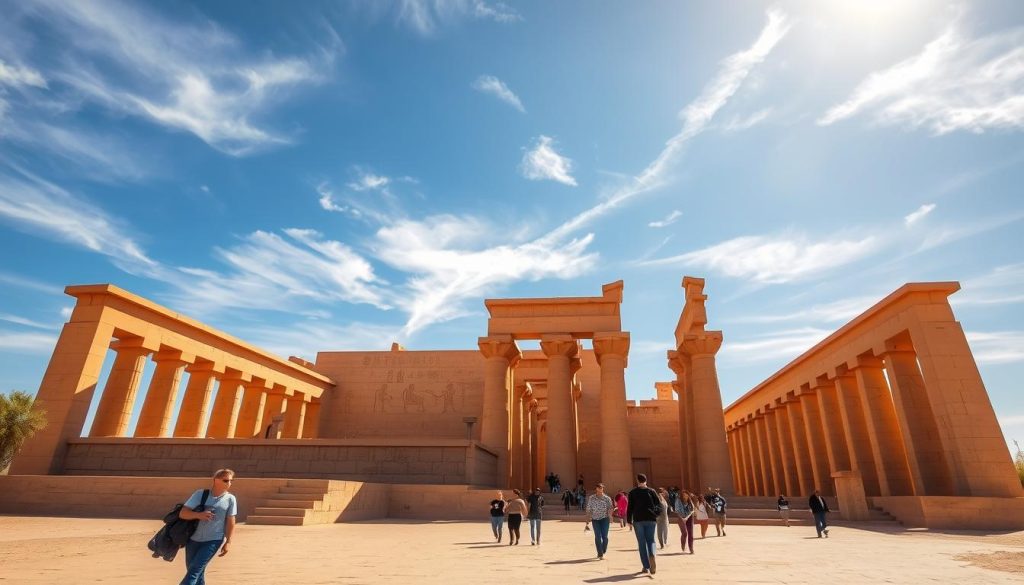
- Iconic Temples: From Luxor Temple to the Temple of Hatshepsut, each site tells a story of power and faith.
- Unique Experiences: Hot air balloon rides offer breathtaking views, while museums provide deep cultural insights.
- Changing Light: Whether at sunrise or sunset, the city’s landmarks transform under different lighting conditions.
Your adventure doesn’t have to end here. Use the travel tips provided to plan your next visit, ensuring a seamless and enriching experience. Whether you’re drawn by history, culture, or simply the thrill of discovery, this city promises to leave you inspired.
So, take the plunge and explore all facets of this incredible destination. From the illuminated temples at night to the serene mornings by the Nile, every moment is a new chapter in your travel story. Your journey is just beginning—let it unfold in the most unforgettable way.
Frequently Asked Questions
Planning your visit to this historic destination? Here are answers to some common questions to help you prepare for an unforgettable experience. Whether you’re curious about tours, entry fees, or local customs, we’ve got you covered.
How do I book a tour? Booking a guided tour is simple. Many operators offer packages that include transportation, tickets, and expert guides. Independent travelers can purchase tickets on-site, but guided tours often provide deeper insights into the history and significance of each site.
What are the entry fees? Entry fees vary by location. Major sites like the Valley of the Kings or Karnak Temple typically cost between $10-$20 per person. Some tombs, like Tutankhamun’s, require an additional fee. Always check the latest prices before your visit.
Is it safe to travel here? Yes, this destination is generally safe for tourists. However, it’s wise to stay aware of your surroundings, especially in crowded areas. Follow local guidelines and respect cultural customs for a smooth experience.
Plan ahead, and you’ll enjoy a seamless journey. From ancient temples to serene river views, this city offers something for every traveler. Your adventure awaits!
The above is subject to change.
Check back often to TRAVEL.COM for the latest travel tips and deals.
Here are some Tours & Sightseeing suggestions that might pique your interests!
